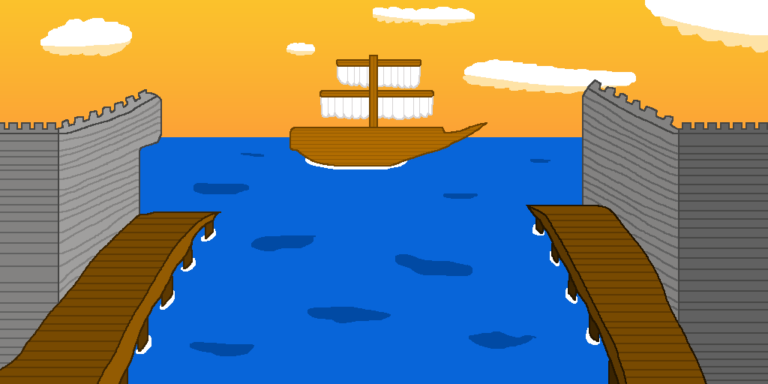Join US
Do you want to build the fantasy world you’ve always dreamed of?
Subscribe to receive notifications when a new post is out and for our monthly newsletter!
You can always unsubscribe anytime.


Ships play a significant role in fantasy worlds, regardless of what technological level they’re in. There’s some that sail the waters and some that fly high in the skies above. One thing is for sure, they were built somewhere and that somewhere would be the fantasy shipyards.
Shipyards in fantasy perform the exact same function as their real world counterparts: building ships. They are an invaluable component of a seafaring kingdom as the naval vessels that are assembled there enable it to protect the waters, both from pirates and hostile nations. They’re crewed by sailors and seamen and form the backbone of the kingdom’s navy.
Fantasy shipyards are not small places where only one ship is built at a time. Rather, they take up some real estate and the larger they are, the more they can build at the same time. Maintaining them isn’t cheap either; the expenses associated with them can put a significant dent in the nation’s treasury.
When considering where to place one, the fundamental rule is that it must be in an area of strategic value to the realm. That means it needs to have easy access not just to the ocean but to the materials needed to construct a battleship or another vessel in the navy. Furthermore, it needs to be close to a place with a sizable presence for workers.
At first glance, you might think that fantasy shipyards just build ships but they impact the world in a meaningful way. First and foremost, they’re a strategic asset for the kingdom. Secondly, the areas where they’re located dramatically affect the economies of all nearby communities and the realm itself.
This is article number twenty-two in the fantasy buildings series. If you want to read more, you can find them on our blog page!
When building a shipyard, there are several crucial elements you absolutely need to include. Not incorporating these elements will hamper their effectiveness which can dampen readers’ immersion in your story as well as the kingdom’s ability to field a mighty navy. The goal is to make them feel real to the characters in your world and your audience.
The first thing all fantasy shipyards need to have are dry docks. They are where the ships are put together. How they’re built is heavily dictated by the world’s technological level. Advanced ones make heavy use of machinery to speed up the assembly process whereas medieval ones use manual labor which takes longer.

The second feature of shipyards is warehouses. Ships consume materials and you can’t have them all lying out in the open due to the weather and seasons. Instead warehouses are used to help safeguard priceless resources like wood and metals from the elements and from theft as well. Warehouses are right next to the dry docks so that workers don’t have to travel much to retrieve them when they’re needed.
In some cases, fantasy shipyards have makeshift residential houses, usually owned by either the company that manufactures them or the kingdom itself. These houses are where the workers dwell when they’re not at work. They’re found not too far away from the shipyards and they’re not exactly the best places to live in. They were built quickly using shoddy materials with the sole purpose of being a living space for the workers and are prone to breaking down.
Fourthly, with how important they are to the kingdom, shipyards are usually a target for theft among other crimes. To prevent materials from being stolen, shipyards have security. Depending on their location, a number of security measures are employed ranging from nearby coastal fortresses acting as the police force to having dogs and armed personnel making regular patrols throughout their shift. All security activities are coordinated through a building that can be slotted in anywhere in the shipyard.
Now comes time for the fun part: figuring out where to place shipyards. It’s tempting to just place them haphazardly but did you know that where you place them will actually determine how effective they will be in the long run? Putting them in areas that make sense is best since they’re unique buildings and no other buildings are capable of doing what they do.
The first consideration for placing one is it must be in an area that makes sense from a strategic viewpoint. That viewpoint consists of several underlying ones such as the water depth, the local terrain, and the climate. There’s a reason why you see the majority of shipyards in places that have pleasant weather nearly all the year though there are just a few found in the cold parts of the world and are only operational at certain points in the year.

Secondly, fantasy shipyards must have easy access to the water. It wouldn’t be a shipyard if it was inland, would it? Having access to the water enables ships to be put to work right away. Additionally, it also means that beforehand, a series of stress tests are used on them to ensure that they won’t break when they’re out in the ocean.
In order to quickly put together a vessel capable of sailing the high sea, a shipyard must be in close proximity to resources such as wood so that transporting them isn’t time-consuming. Since many worlds in fantasy depict medieval times, wood is the number one resource used in the construction of ships. As such, shipyards are found near large forests.
The fourth consideration is the labor market. With how labor intensive building a ship is, fantasy shipyards need to have a readily source of labor available. In many cases, they’re found within large cities alongside the ocean or another large body of water. This ensures that they can effortlessly recruit additional workers as needed and not lose much production time.
Being considered major strategic assets to the kingdom, it shouldn’t come as a surprise that fantasy shipyards are an invaluable contribution to the world. They are the chief builders of the ships used by the realm for commercial, residential, and militaristic purposes and are therefore considered a top target for enemy nations in times of war.
Powerful, wealthy companies and the royal government itself are the major customers for fantasy shipyards. Companies seeking to protect their interests abroad contract shipyards to build them vessels that enable them to move their goods across the water safely whereas the king taps them to assemble the nation’s navy. This leads to lucrative profits for the shipyards since they can use their profits to expand their operations.

Shipyards are a major jobs driver in the areas they’re in. The number of workers they employ and the number of resources they consume when constructing a naval vessel require a more than ample workforce to handle all their needs. They’ll need to hire and train their employees. Their employees can use the money they get from their jobs at local shops and other businesses, helping generate revenue for the cities you find them in.
They have deals with local manufacturing companies to make the finished resources they need which can generate profits for the companies and the cities as well. Deals with mining and lumber companies means they have a steady source for the materials they need so that they can continue production without fear of running out. In some cases, they even create subsidiary companies so that they have complete control of the process from beginning to end.
During wartime, fantasy shipyards are usually one of the first targets to be attacked from sea. Severely damaging them deals a crippling blow to the kingdom’s ship-making production, thereby making it easier for hostile nations to gain control of the sea. To prevent this from occurring, they have a sizable number of ships patrolling the area as well as other defensive measures designed to bring the attack to a screeching halt.
In sum, fantasy shipyards are an impressive and essential component of worldbuilding. They are where the ships used by all seafaring kingdoms are built. These vessels have the power to explore new frontiers, transport people and goods across water, and have the capability to cause destruction.
Shipyards are made up of several integral components. The most important one, the dry docks, facilitate the construction of naval vessels. Others such as the warehouse and security headquarters serve their own purpose. Using all of them helps ensure you have shipyards that fit seamlessly in your world.
Though you may have everything you need to put together a shipyard, where you put it will determine whether it survives or winds up being a flop. The best ones are located in areas that make sense for them, not those that don’t. A bevy of factors such as terrain and climate dictate the best spots to put them.
In regard to the world, the shipyards contribute to it in several significant ways. One such one is how it can affect the economies of local communities. They expend a great deal of resources in constructing the naval fleet of the kingdom and those used by private companies to ferry people and goods to distant lands.
Fantasy shipyards are a great boon to worldbuilding and you can’t go wrong with bringing them into your world!
Let me know what you think in the comments below. (Note: this is an account-exclusive feature).
If you don’t have one, you can register here. It only takes a few moments of your time!
Liked this article and want to subscribe? All you have to do is fill out the form below and that’s it!
Thanks for reading this and until the next time,
Sunfire
Subscribing means you receive:
You can always unsubscribe anytime.
Do you want to build the fantasy world you’ve always dreamed of?
Subscribe to receive notifications when a new post is out and for our monthly newsletter!
You can always unsubscribe anytime.